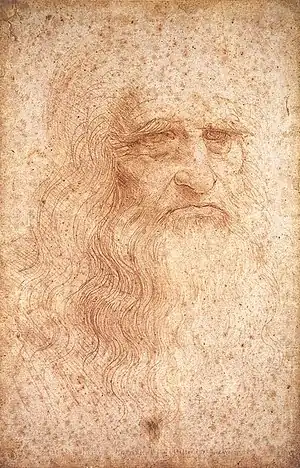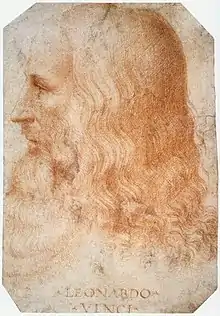Portrait of a Man in Red Chalk
The portrait of a man in red chalk (c. 1510) in the Royal Library of Turin is widely, though not universally, accepted as a self-portrait of Leonardo da Vinci. It is thought that Leonardo da Vinci drew this self-portrait at about the age of 60. The portrait has been extensively reproduced and has become an iconic representation of Leonardo as a polymath or "Renaissance Man". Despite this, some historians and scholars disagree as to the true identity of the sitter.
| Portrait of an elderly man | |
|---|---|
 The inscription at the bottom of the portrait, added by a later hand, reads: "Leonardo da Vinci, portrait of himself as an old man"[1] | |
| Artist | Leonardo da Vinci |
| Year | c. 1512 |
| Type | Red chalk on paper |
| Dimensions | 33.3 cm × 21.6 cm (13.1 in × 8.5 in) |
| Location | Royal Library, Turin |
Description and provenance
The portrait is drawn in red chalk on paper. It depicts the head of an elderly man in three-quarter view, his face turned towards the viewer. The subject is distinguished by his long hair and long waving beard which flow over the shoulders and chest. The length of the hair and beard is uncommon in Renaissance portraits and suggests, as now, a person of sagacity. The face has a somewhat aquiline nose and is marked by deep lines on the brow and pouches below the eyes. It appears as if the man has lost his upper front teeth, causing deepening of the grooves from the nostrils. The eyes of the figure do not engage the viewer but gaze ahead, veiled by the long eyebrows.
The drawing has been drawn in fine unique lines, shadowed by hatching and executed with the left hand, as was Leonardo's habit. The paper has brownish "fox marks" caused by the accumulation of iron salts due to moisture. It is housed in Turin, at the Royal Library, and is not generally viewable by the public due to its fragility and poor condition.[2] Researchers have developed a nondestructive way to gauge the condition of the drawing by describing and quantifying the chromophores affecting the paper. Their technique, described in Applied Physics Letters (2014), will be used to assess the rate at which the image is deteriorating and should help with planning appropriate conservation strategies.[3]
History and attribution
The drawing is estimated to have been drawn c. 1510, possibly as a self-portrait by Leonardo da Vinci. In 1839, it was acquired by King Carlo Alberto of Savoy.[2] The assumption that the drawing is a self-portrait of Leonardo was made in the 19th century, based on the similarity of the sitter to the possible portrait of Leonardo as Plato in Raphael's The School of Athens[2] and on the high quality of the drawing, consistent with others by Leonardo. It was also decreed to be a self-portrait based on its likeness to the frontispiece portrait of Leonardo in Vasari's second edition of The Lives of the Artists (1568). During World War II, the presumed self-portrait was temporarily moved from Turin to Rome to avoid being taken by the Nazis, becoming somewhat damaged in the process.[4] In 2000, Frank Zöllner reflected that "This red chalk drawing has largely determined our idea of Leonardo's appearance for it was long taken to be his only authentic self-portrait."[5]
Since the mid-to-late 20th century, the identification of the drawing as a self-portrait has been questioned.[2][6] The claim that it represents Leonardo has been criticized by a number of Leonardo scholars and experts, such as Robert Payne,[7] Martin Kemp, Pietro Marani, Carlo Pedretti, Larry J. Feinberg,[8] and Martin Clayton.[9] A frequent criticism made in the late 20th century is that the drawing depicts a man of a greater age than Leonardo himself achieved, as he died at the age of 67 and allegedly made the drawing between the age of 58 and 60.[2] It has been suggested that the sitter represents Leonardo's father Piero da Vinci or his uncle Francesco, based on the fact they both had a long life and lived until the age of 80.[2][10]
In the early 21st century, the presumed self-portrait of Leonardo was used to help identify the subject of a drawing by Giovanni Ambrogio Figino, believed to depict an elderly Leonardo with his right arm assuaged by cloth.[11][12] This may correspond with accounts of Leonardo's right hand being paralytic late in life[13] and the burial position of his presumed remains,[14] which scientists hope to DNA test to determine if they are Leonardo's.[15]
Other portraits

Other portraits of Leonardo by himself and other hands exist, presenting a different image of Leonardo to the man as represented in the red chalk drawing. Another red chalk drawing, a profile portrait at Windsor, is attributed to his pupil Francesco Melzi. A sketch by an unknown assistant on the back of one of Leonardo's studies (c. 1517) has also been determined to be a portrait.[9] A self-portrait from Leonardo's Codex on the Flight of Birds depicts the artist at age 53.[16][17] Leonardo may have also included a self-portrait in Luca Pacioli's Divina proportione, which he illustrated.[18] A 1471 painting of Gabriel bears an inscription indicating that it is a self-portrait of Leonardo; this would be the earliest depiction of the artist.[19]
Leonardo is thought to be portrayed as Plato in Raphael's The School of Athens (1511).[2] He may have been the model for two works by his master Verrocchio: the bronze statue of David (c. 1476) in the Bargello, and the archangel Raphael in Tobias and the Angel (c. 1475).[20] Donato Bramante's Heraclitus and Democritus (1477) is thought by some to portray Leonardo as Heraclitus.[21][lower-alpha 1] Some suspect that the lower-right attendant in Leonardo's Adoration of the Magi (1481) may be a self-portrait. A 1505 engraving by Marcantonio Raimondi may portray Leonardo playing a lira da braccio, but this has yet to be verified.[17][lower-alpha 2]
There is no scholarly consensus on the attribution of the Lucan portrait to Leonardo, but it has at least on occasion been attributed to him.[24] The engraving portrait by Raffaello Morghen and statue by Luigi Pampaloni were made after his lifetime. Romantic paintings by Jean-Auguste-Dominique Ingres, François-Guillaume Ménageot and other French artists, as well as Angelica Kauffman depict the legendary account of Leonardo's death in the hands of King Francis I of France.
References
Footnotes
- By the same accounts, Bramante portrayed himself as Democritus.[21]
- Leonardo was known for playing another stringed instrument, the lyre.[22][23]
Citations
- Wallace, Robert (1972) [1966]. The World of Leonardo: 1452–1519. New York: Time-Life Books. p. 172.
- Scaramella, A. D. (21 December 2012). "Artwork Analysis self Portrait in Red Chalk by Leonardo Da Vinci". Finearts.com. Helium Inc. Archived from the original on November 29, 2014. Retrieved 14 November 2014.
- "Visual degradation in Leonardo da Vinci's iconic self-portrait: A nanoscale study".
- Muñoz-Alonso, Lorena (3 November 2014). "Why Was Da Vinci's Self-portrait Hidden from Hitler?". artnet News. Retrieved 6 May 2019.
- Frank Zöllner, Leonardo da Vinci, Taschen (2000)
- "Emergency Treatment for Leonardo da Vinci's Self-Portrait". news.universityproducts.com. Archival Products. Retrieved 16 November 2014.
- Payne, Robert (1978). Leonardo (1st ed.). Doubleday. p. 344. ISBN 0385041543. Retrieved 13 November 2014.
- Feinberg, Larry J. (29 Aug 2011). The Young Leonardo: Art and Life in Fifteenth-Century Florence. Cambridge University Press. p. 63. ISBN 1139502743. Retrieved 13 November 2014.
- Brown, Mark (1 May 2019). "Newly identified sketch of Leonardo da Vinci to go on display in London". The Guardian. Retrieved 2 May 2019.
- Ghose, Tia. "Vanishing da Vinci Portrait Could Be Saved by Science". LiveScience. Purch. Retrieved 12 November 2014.
- Strickland, Ashley (4 May 2019). "What caused Leonardo da Vinci's hand impairment?". CNN. Retrieved 4 May 2019.
- McMahon, Barbara (1 May 2005). "Da Vinci 'paralysis left Mona Lisa unfinished'". The Guardian. Retrieved 2 May 2019.
- Bodkin, Henry (4 May 2019). "Leonardo da Vinci never finished the Mona Lisa because he injured his arm while fainting, experts say". The Telegraph. Retrieved 6 May 2019.
- Charlier, Philippe; Deo, Saudamini. "A physical sign of stroke sequel on the skeleton of Leonardo da Vinci?". Neurology. 4 April 2017; 88(14): 1381–82
- Knapton, Sarah (5 May 2016). "Leonardo da Vinci paintings analysed for DNA to solve grave mystery". The Daily Telegraph. Retrieved 5 May 2019.
- "Leonardo da Vinci and the Idea of Beauty – Muscarelle Museum of Art". Muscarelle Museum of Art. 28 October 2014. Retrieved 6 May 2019.
- Cascone, Sarah (2 June 2015). "New Leonardo da Vinci Portrait Discovered". artnet News. Retrieved 6 May 2019.
- Shana Priwer, Cynthia Phillips (2005). 101 things you didn't know about Da Vinci: the secrets of the world's most eccentric and innovative genius revealed! Adams Media; pp. 167–168. ISBN 1-59337-346-5
- "Svelata maiolica che ritrae l'Arcangelo Gabriele. "è la prima opera di Leonardo"". Repubblica.it (in Italian). 21 June 2018. Retrieved 8 May 2019.
- della Chiesa, Angela Ottino (1967). The Complete Paintings of Leonardo da Vinci. p. 83.
- Nicholl, Charles (2005). Leonardo Da Vinci: The Flights of the Mind. Penguin Books. p. 425. ISBN 978-0-14-194424-1.
- Bacci, Mina (1978) [1963]. The Great Artists: Da Vinci. Translated by Tanguy, J. New York: Funk & Wagnalls.
- Wallace, Robert (1966). The World of Leonardo: 1452–1519. New York: Time-Life Books. p. 12.
- "Self Portrait of Leonardo". Surrentum Online. Retrieved 8 May 2019.
External links
| Wikimedia Commons has media related to So-called self-portrait by Leonardo da Vinci in the Biblioteca Reale in Turin. |
- Leonardo da Vinci: anatomical drawings from the Royal Library, Windsor Castle, exhibition catalog fully online as PDF from The Metropolitan Museum of Art, which contains material on Self-Portrait (see index)